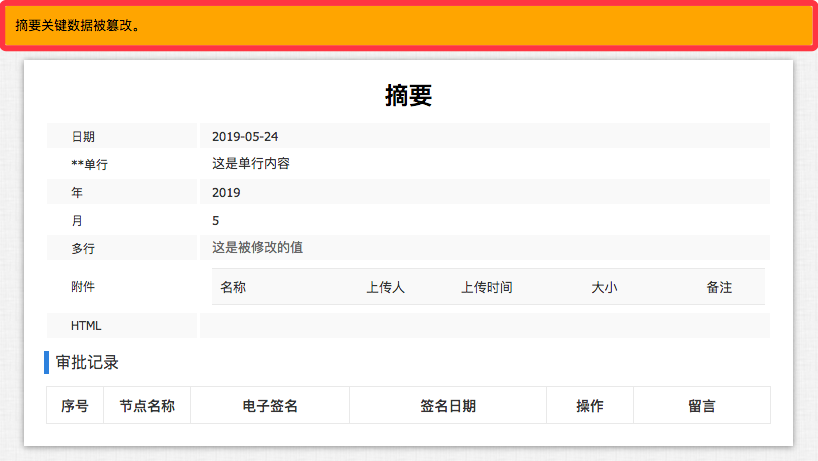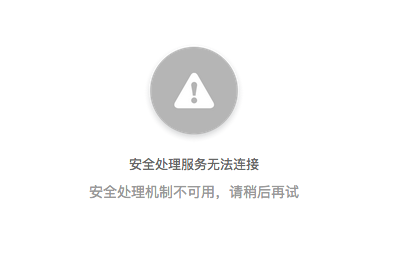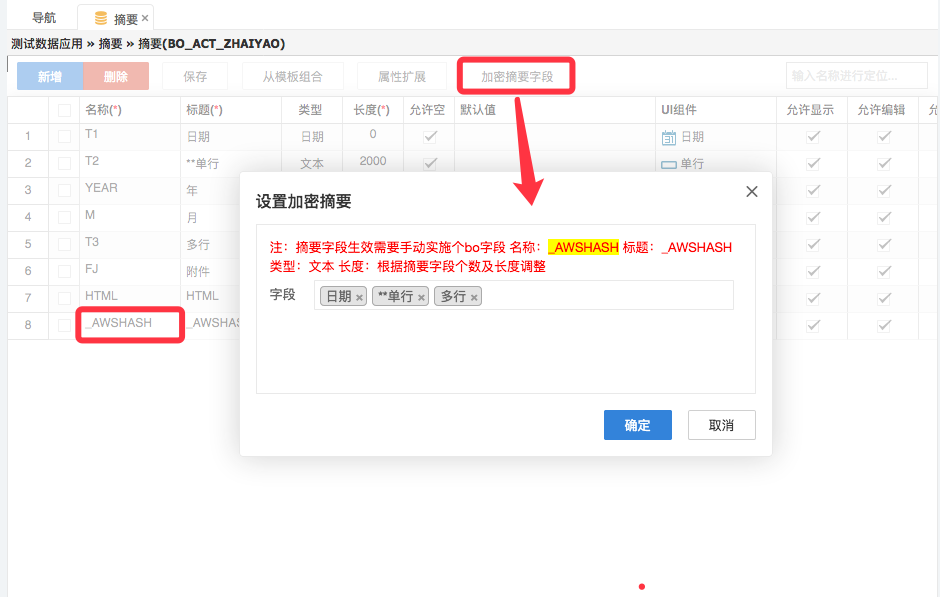代码示例
SecurityProcessorDemo
package com.actionsoft.apps.poc.plugin.security;
import java.io.FileInputStream;
import java.io.InputStream;
import java.util.Map;
import com.actionsoft.bpms.commons.security.processor.AESSecurityProcessor;
import com.actionsoft.bpms.commons.security.processor.AbstractSecurityProcessor;
import com.actionsoft.bpms.server.fs.DCContext;
public class SecurityProcessorDemo extends AbstractSecurityProcessor {
/**
* 加密文本
*
* @return 加密后的文本
* @params params
*/
public String encryptContent(Map<String, Object> params) {
// 需要加密的内容
String content = (String) params.get("content");
// 平台传入的密码,根据需要使用
String password = (String) params.get("password");
//加密具体代码
//TODO
String encryptedContent = content;
// return encryptedContent;
// 如果该方法不需要处理,则需要调用平台自身的处理机制,代码如下:
return AESSecurityProcessor.getInstance().encryptContent(params);
}
/**
* 解密文本
*
* @return 解密后的文本
* @params params
*/
public String decryptContent(Map<String, Object> params) {
// 需要解密的内容
String content = (String) params.get("content");
// 平台传入的密码,根据需要使用
String password = (String) params.get("password");
// 解密具体代码
//TODO
String originContent = content;
// return originContent;
// 如果该方法不需要处理,则需要调用平台自身的处理机制,代码如下:
return AESSecurityProcessor.getInstance().decryptContent(params);
}
//----------------这是分隔线以下两个方法为6.3.GA及以后版本请使用----------------------
/**
* 返回解密包装流
*
* @param is 要解密的文件流
* @param password 取自文件路经的一段信息
* @return 解密后的文件流
* @throws Exception
* @since 6.3.GA及以后使用该接口
*/
public InputStream decrypt(InputStream is, String password, Map<String, Object> params) throws Exception {
return AES.decrypt(is, password);
}
/**
* 返回加密包装流
*
* @param is 待加密的文件流
* @param password 取自文件路经的一段信息
* @return 加密后的文件流
* @throws Exception
* @since 6.3.GA及以后使用该接口
*/
@Override
public InputStream encrypt(InputStream is, String password, Map<String, Object> params) throws Exception {
return AES.encrypt(is, password);
}
//----------------这是分隔线以下两个方法为6.3.3 6.3.2 6.3.1版本请使用----------------------
/**
* 加密文件
*
* @return 文件大小
* @params params
*/
public Integer encryptFile(Map<String, Object> params) {
// 平台传入的密码,根据需要使用
String password = (String) params.get("password");
// 需要加密的文件路径
String path = (String) params.get("path");
int fileSize = 0;
File inFile = new File(path);
FileInputStream in = null;
try {
//加密具体代码
//TODO
in = new FileInputStream(inFile);
fileSize = in.available();
} catch (Exception e) {
// TODO Auto-generated catch block
e.printStackTrace();
}
return fileSize;
// 如果该方法不需要处理,则需要调用平台自身的处理机制,代码如下:
// return AESSecurityProcessor.getInstance().encryptFile(params);
}
/**
* 解密文件
*
* @return
* @params params
*/
public InputStream decryptFile(Map<String, Object> params) {
String password = (String) params.get("password");
// 需要解密的文件路径
String path = (String) params.get("path");
// DC存储控制器上下文对象
DCContext context = (DCContext) params.get("context");
FileInputStream in = null;
try {
in = new FileInputStream(path);
int len = in.available();
if (len > 0) {
byte[] buf = new byte[len];
try {
in.read(buf, 0, len);
ByteArrayInputStream byteArrayInputStream = new ByteArrayInputStream(buf);
//解密具体代码
//TODO
return byteArrayInputStream;
} finally {
try {
if (in != null)
in.close();
context.setDCMessage(DCMessage.OK, I18nRes.findValue(AppsConst.SYS_APP_PLATFORM, "文件已读取完毕"));
} catch (Exception e) {
e.printStackTrace(System.err);
}
}
}
return null;
} catch (Exception e) {
e.printStackTrace(System.err);
return null;
} finally {
try {
if (in != null)
in.close();
in = null;
} catch (Exception e) {
e.printStackTrace(System.err);
}
}
// 如果该方法不需要处理,则需要调用平台自身的处理机制,代码如下:
// return AESSecurityProcessor.getInstance().decryptFile(params);
}
//---------------------这是分隔线结束-----------------------------
/**
* 计算摘要
* @param params data 需要摘要的数据
* @return
*/
//当重写该方法后,且`平台安全处理机制`配置为此处理机制时,AWS BO表将提供`加密摘要字段`按钮,详细参见以下`BO表数据摘要`章节
//用户也可以在自己需要的场景调用该方法实现摘要防篡改功能
public String calculateHashcode(Map<String, Object> params) {
// 需要摘要数据
String data = (String) params.get("data");
// 具体摘要算法
//TODO
String hashCode = data;
return hashCode;
}
/**
* 判断安全处理器是否可用。如加密机制用到第三方服务,需要判断第三方服务是否可用,如果调用不成功的时候,则会阻止表单打开。
* 该验证算法,要和加解密的算法保持一致,否则会导致数据加解密错误,导致数据丢失
*
* @param params
* @return true,表示该处理器正常使用;否则不可用
*/
public boolean isAvailable(Map<String, Object> params) {
return true;
}
/**
*用户登录密码的算法调整
*
*/
//当重写该方法后,需重新实现AWS PaaS平台登录适配器,详细参见下面`用户登录密码算法调整登录适配器`章节
public String getPassword(String userId, String pwd) {
// demo,仅返回不加密的密码,请不要应用到生产环境
return pwd;
}
}
将SecurityProcessorDemo注册至PluginListener监听器
com.actionsoft.apps.poc.plugin.Plugins
public class Plugins implements PluginListener {
@Override
public List<AWSPluginProfile> register(AppContext appContext) {
List<AWSPluginProfile> list = new ArrayList<AWSPluginProfile>();
list.add(new SecurityProcessorProfile("SECURITY-DEMO", "安全处理机制Demo", SecurityProcessorDemo.class.getName(), "安全处理机制Demo"));
return list;
}
}
注意:在AWS CONSOLE的应用管理 > 应用开发 > 配置应用或AWS Developer中配置该App的扩展插件选项为com.actionsoft.apps.poc.plugin.Plugins
用户登录密码算法调整登录适配器
重写AbstractSecurityProcessor抽象类中的getPassword方法后,必须重新实现AWS PaaS平台登录适配器。
用户登录密码算法调整登录适配器示例代码如下:
package com.actionsoft.apps.poc.plugin.adapter;
import com.actionsoft.bpms.commons.login.LoginAdapterInterface;
import com.actionsoft.bpms.commons.login.constant.LoginConst;
import com.actionsoft.bpms.commons.login.control.LoginContext;
import com.actionsoft.bpms.commons.login.control.LoginResult;
import com.actionsoft.bpms.commons.security.processor.AESSecurityProcessor;
import com.actionsoft.bpms.commons.security.processor.SecurityProcessorHelper;
import com.actionsoft.bpms.org.cache.UserCache;
import com.actionsoft.bpms.org.dao.OrgDaoFactory;
import com.actionsoft.bpms.org.model.UserModel;
public class PWDHashChangeLoginAdapterDemo implements LoginAdapterInterface {
/**
* 依据Context获取登录信息,进行登录检验
*
* @return 返回校验结果
*/
public LoginResult validate(LoginContext context) {
LoginResult lr = new LoginResult();
// 确定uid
String localUID = context.getUid();
// 对应本地的AWS账户
lr.setLocalUID(localUID);
UserModel userModel = UserCache.getModel(localUID);
if (userModel == null) {// 本地未发现该账户
lr.setStatus(LoginConst.LOGIN_STATUS_ERR1);
return lr;
} else if (userModel.isClosed()) {
// 账户已被注销
lr.setStatus(LoginConst.LOGIN_STATUS_ERR2);
return lr;
}
String pwd = context.getPwd();
String oldPwdHash = AESSecurityProcessor.getInstance().getPassword(localUID, pwd);
if (oldPwdHash.equals(userModel.getPassword())) {
//旧版本的密码摘要值和数据库中的值一致,则说明用户登录的密码正确。
//这时,需要修改数据库中的密码
changePassword(localUID, pwd);//传入明文密码,内部会调用新算法计算密码摘要值
lr.setStatus(LoginConst.LOGIN_STATUS_OK);
return lr;
} else {
//如果不相等,则是已经处理过新算法了
String newPwd = SecurityProcessorHelper.getPassword(localUID, pwd);
if (newPwd.equals(userModel.getPassword())) {//新算法和数据库中的摘要比较
lr.setStatus(LoginConst.LOGIN_STATUS_OK);
return lr;
} else {
// 密码不通过
lr.setStatus(LoginConst.LOGIN_STATUS_ERR1);
return lr;
}
}
}
//重写`AbstractSecurityProcessor`抽象类中的`getPassword`方法后会导致平台的密码摘要改变,所以需要将新的密码摘要内容存储到数据库中
private void changePassword(String uid, String pwd) {
UserModel model = UserCache.getModel(uid);
if (model != null) {
OrgDaoFactory.createUser().setPassWord(model.getUniqueId(), pwd);//pwd是明文的
}
}
}
有关登录适配器详细介绍请参考这里
BO表数据摘要
重写AbstractSecurityProcessor抽象类中的calculateHashcode方法后,且AWS BPMS平台的安全处理机制(SecurityProcessorId)参数配置为该插件注册名时,BO表将提供加密摘要字段按钮。
按照提示说明,配置加密摘要字段后,在打开表单时将自动对被摘要字段进行安全检查,如果发现字段值被从数据库直接修改过,打开的表单将不可修改与办理,并有明显提示信息。


Seven

010-62962343-690

liujx@actionsoft.com.cn
感谢您对该文档的关注!如果您对当前页面内容有疑问或好的建议,请与我联系。如果您需要解答相关技术问题请登录AWS客户成功社区

